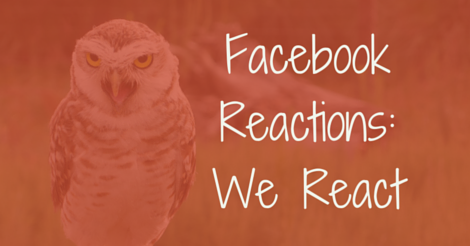
Since the announcement that Facebook are responding to requests for a ‘dislike’ button, speculation on the story has been rife. What will the button look like? How exactly would an ’empathy’ button work? Would people even use it, or would they resist the idea? Last week (almost) all of our questions were put to bed at last, as we finally got a glimpse of Facebook’s new ‘reactions’.
Currently testing in Spain and Ireland, the ‘reactions’ emojis will be rolled out internationally in the coming months.
A hybrid of static emojis and animated GIFs, reactions will offer Facebook users a wider range of options when responding to content with one click. Where before the only options were to like or to comment, there will now be an array of other emotions to choose from, including ‘love’ ‘haha’ ‘wow’ ‘sad’ and ‘angry’.
A great idea?
At first glance, the concept of the new reactions seems like a masterstroke.
Emojis have gained immense popularity largely due to their ability to transcend language barriers. Tapping into the huge popularity of emojis allows immediate and widely-comprehensible communication.
On top of that, the simple mechanism (hold and tap to select a reaction) removes any concerns that the new reactions will be too complicated for users to adopt quickly.
We should have a great respect for Facebook, too, for not caving to demands for a ‘dislike’ button. Mark Zuckerberg expressed concerns that this would build an atmosphere of up-and-downvoting, which it’s feared would create a negative user experience. Instead, they’ve opted for a solution that will let them encourage the positive atmosphere they want to foster on their network– or so it’s hoped.
The initial public reaction, however, seems far from delighted with these new developments.
Not the reaction Facebook hoped for…
Put kindly, the overwhelming reaction seems to be one of cynicism– the slightly teary ‘sad’ emoji seems an insufficient response to the kind of tragedy Facebook spoke about when they announced the need for an empathy button.
I’m clearly not the only one who thinks so– one need only take a look at the backlash against USA Today’s use of the new reactions to accompany serious news stories in print to see that their use could open people and businesses up to severe criticism. Perhaps the incident was intended as a statement on the inappropriateness of boiling news stories down to one simplistic icon. If so, the paper certainly made its point.
When it comes to it, a considered and personalised old-school comment seems to me like a far more empathetic response to someone’s misfortune than a one-size fits all crying face.
What does this mean for brands?
It’s likely that as a business, the reactions’ lack of complexity will be less of an issue– indeed, reactions could well be a positive force for brands hoping to connect with their fans on the network. After all, they’ll afford us a deeper level of understanding of our audience’s feelings on certain posts– and without the need to decipher any comments for the emotions behind them.
This does raise the question, though, of how these new additions will change the behind-the-scenes post analysis. There will be much more information to process, as brands get an insight into which content– funny, inspirational or tugs-at-the-heartstrings– is most popular, or even whether content designed for a specific purpose is doing what it’s meant to. Though it may mean getting to grips with new analytics, a nuanced insight into fans’ preferences could be a powerful tool for marketers looking to hone their content.
Many brands will no doubt also be worried about the potential of reactions as an outlet for negative feedback on their posts. Whether page fans will embrace the ‘angry’ face to deliver negative feedback to brands on Facebook is yet to be seen, though it’s certainly a possibility.
This is surely no more concerning than a scathing Facebook comment, though– and if we’re worrying about provoking an ‘angry’ reaction, perhaps we need to take a look at the content we’re delivering as brands, rather than the mechanism our fans use to feed back to us.
What’s your take on the new reactions? Worried about what the new reactions could mean for your business? Excited to start using them when they’re introduced in your location? Let us know your thoughts!
– Moya Vaughan Evans
